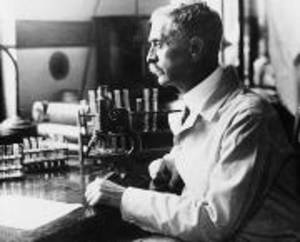Blood Types

Nobel Prize-winning immunologist Karl Landsteiner was born on this date in 1868 in Vienna.
After studying chemistry (with Emil Fischer, among others) and medicine, Landsteiner settled in Vienna to teach pathological anatomy. He was interested in the practice of blood transfusion to counteract blood loss in patients, once discredited for some years, but experiencing a resurgence during the 19th century. The problem with it was that sometimes transfused blood clotted inexplicably, leading to severe kidney problems, and sometimes the transfusion worked just fine. Assuming that there were intrinsic similarities and differences in blood from different humans, Landsteiner began to analyze human blood and arrived at a set of simple categories, based on blood cell antigens, which could allow medical professionals to know who could give and receive blood transfusions safely: people with type A blood could receive blood from type A and O donors; people with type B blood, from B and O donors; people with type O blood, only from O donors; and people with type AB blood (discovered later), from all donors.
Following Charles Drew's pioneering work on blood preservation during the 1930s, blood transfusions became a routine procedure. In addition to aiding successful blood transfusions, Landsteiner’s blood types also helped determine paternity, opened the way for successful organ transplantation and became invaluable in genetic studies of the origins of human populations. Landsteiner fled politically chaotic Vienna in 1922 and joined the Rockefeller Institute in New York City, and won the Nobel Prize for Medicine in 1930 for his discoveries.
Landsteiner was also the first to discover that allergies had an immunochemical basis; defined the relationships between antibody and antigen with chemical precision, thus encouraging the pursuit of effective prophylactic immunization; isolated the virus which caused polio, which ultimately empowered Jonas Salk’s work on the polio vaccine; and discovered the Rh blood factor, linking it to brain damage and death in newborn infants and leading to the design of a life-saving test for infants. Landsteiner’s lifetime of discovery involved a great deal of lab work and animal experimentation (including the use of Rhesus monkeys as experimental confederates in the treatment of syphillis) -- a fact which animal rights activists have narrowmindedly held against him -- and he personally performed 3,639 human postmortem examinations.
After he was awarded the Nobel Prize, his fame grew, but being a somewhat timid man he never felt comfortable with his notoriety, preferring the solace of the laboratory. He died at his lab bench on June 26, 1943 in New York City.
Categories: Biologists-&-Physiologists





0 Comments:
Post a Comment
Subscribe to Post Comments [Atom]
<< Home